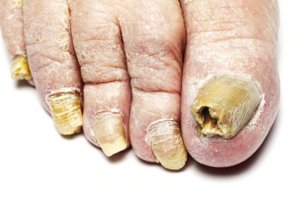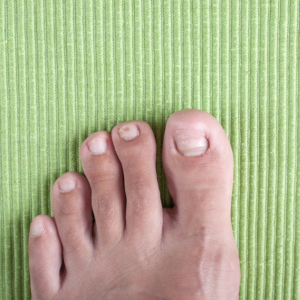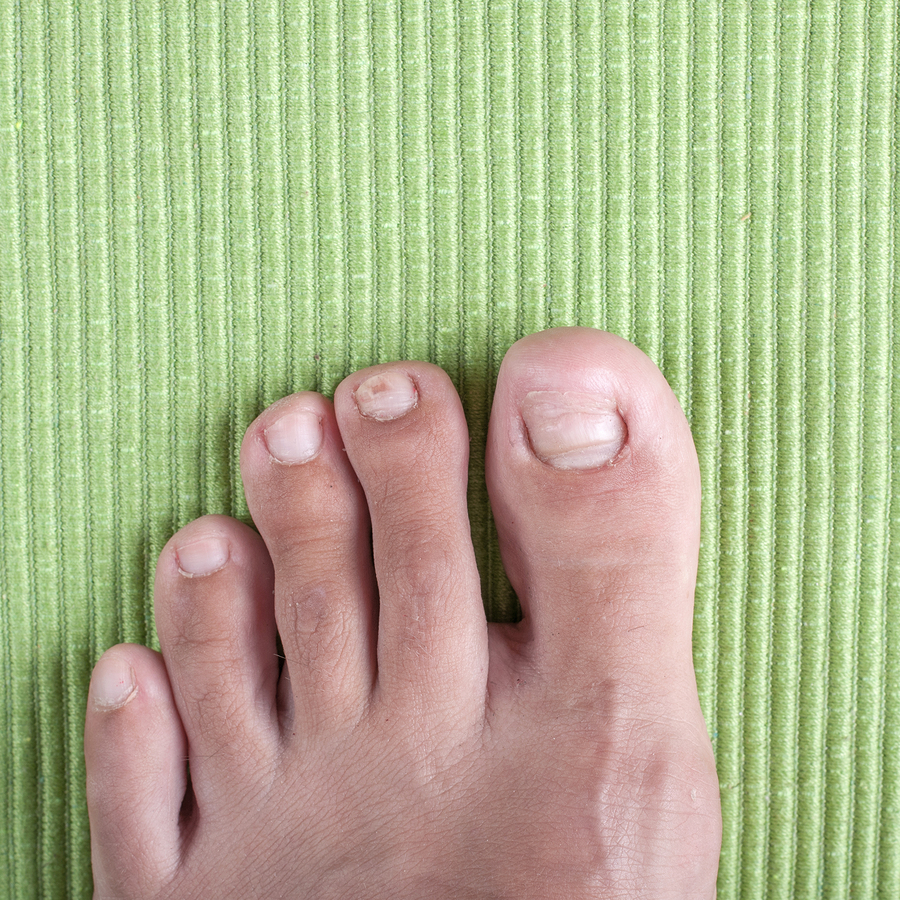Several patients have asked us this question over the years – “Why do my toenails fall off?” This can be especially perplexing when there has been no obvious trauma to the toe or nail….. So I thought I would explain two of the most common causes for this cyclical condition.
 One cause for loose nails or nails which completely fall off with very little manipulation is nail fungus. A mild fungal infection may present as white specks or flecks within the surface of the nail. As infection worsens, the fungus will invade the middle portion of the nail plate and work its way through the nail, infecting the nail bed (the soft tissue to which a nail adheres), as well as cause thickening and discoloration ranging from yellow to brown to black or even green. Fungus thrives in a moisture environment. The construct of the fungal matter embedded between the nail plate and nail bed is such that it will retain moisture, further enabling its optimal growth environment. This fungal matter is difficult for patients to extract on their own. Additionally, it is difficult to adequately dry under a fungal or sometimes partially lifting nail. The fungal growth, as slow growing as it may be, typically progresses despite patients’ efforts to cure it with over the counter products. With severe fungal infections, the actual nail plate becomes replaced by the fungal matter. This is why at times we can trim back a patient’s nail in its entirety.
One cause for loose nails or nails which completely fall off with very little manipulation is nail fungus. A mild fungal infection may present as white specks or flecks within the surface of the nail. As infection worsens, the fungus will invade the middle portion of the nail plate and work its way through the nail, infecting the nail bed (the soft tissue to which a nail adheres), as well as cause thickening and discoloration ranging from yellow to brown to black or even green. Fungus thrives in a moisture environment. The construct of the fungal matter embedded between the nail plate and nail bed is such that it will retain moisture, further enabling its optimal growth environment. This fungal matter is difficult for patients to extract on their own. Additionally, it is difficult to adequately dry under a fungal or sometimes partially lifting nail. The fungal growth, as slow growing as it may be, typically progresses despite patients’ efforts to cure it with over the counter products. With severe fungal infections, the actual nail plate becomes replaced by the fungal matter. This is why at times we can trim back a patient’s nail in its entirety.
Likewise, with very little manipulation or trauma (sock catching, minor bump of the toe and/or nail, or while a patient is trimming his or her own nails) nails can simple “fall off” or crumble away.
 The second reason for the a-traumatic loss of toenails is in-growing nails. Ingrown toenails are those which have incurvated or excessively curved nail borders (the sides of the nail). This is a hereditary condition. Certain structural deformities such as bunions (which cause two toes to come in closer contact than normal) can also cause a nail to curve over time, in response to pressure. In any event, when an ingrowing nail gets long, it can cause pressure and pain on the skin immediately in front of it. Patients often elect to trim back this portion of nail. However, cutting the nail shorter allows the skin just in front of it to roll back and abut against the edge of the nail while walking, ultimately leading to a “rounded” appearance of the skin at the end of the toe. The nail growth center, or “matrix” lies just proximal to the nail (under and behind the cuticle area). When we walk and the ground presses against the tip of the toe, the rounded skin presses against the nail edge, creating a back pressure on the harder nail plate. Normal nail growth, from soft nail cells to hardened nail plate, is a continuous process – such as what might occur on a conveyor belt. Any back pressure from the hard nail plate onto the soft nail cells can cause a defect at the line where the two meet and can cause stunted nail growth, horizontal or curved ridges in the nail plate, or even a complete severance of the continuum, whereby the existing nail plate becomes disconnected from the newly forming soft portion of the nail. As this new nail continues to grow, now under the existing nail plate, it can push the upper nail out and eventually cause it to loosen and fall off. This also explains why people can develop a “double” nail.
The second reason for the a-traumatic loss of toenails is in-growing nails. Ingrown toenails are those which have incurvated or excessively curved nail borders (the sides of the nail). This is a hereditary condition. Certain structural deformities such as bunions (which cause two toes to come in closer contact than normal) can also cause a nail to curve over time, in response to pressure. In any event, when an ingrowing nail gets long, it can cause pressure and pain on the skin immediately in front of it. Patients often elect to trim back this portion of nail. However, cutting the nail shorter allows the skin just in front of it to roll back and abut against the edge of the nail while walking, ultimately leading to a “rounded” appearance of the skin at the end of the toe. The nail growth center, or “matrix” lies just proximal to the nail (under and behind the cuticle area). When we walk and the ground presses against the tip of the toe, the rounded skin presses against the nail edge, creating a back pressure on the harder nail plate. Normal nail growth, from soft nail cells to hardened nail plate, is a continuous process – such as what might occur on a conveyor belt. Any back pressure from the hard nail plate onto the soft nail cells can cause a defect at the line where the two meet and can cause stunted nail growth, horizontal or curved ridges in the nail plate, or even a complete severance of the continuum, whereby the existing nail plate becomes disconnected from the newly forming soft portion of the nail. As this new nail continues to grow, now under the existing nail plate, it can push the upper nail out and eventually cause it to loosen and fall off. This also explains why people can develop a “double” nail.
Stay tuned for answers as to how to remedy these problematic and annoying nail conditions!
If you can’t wait for the follow-up blog, call to see one of our doctors at Tri-State Foot and Ankle Center, where we will give you options you feel comfortable with. We are ultimately here for you! For more information, visit our Facebook Page!
